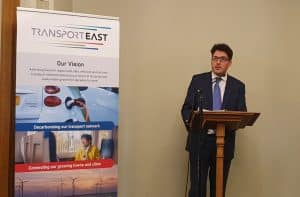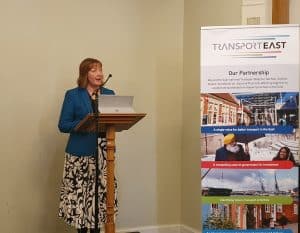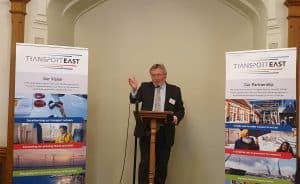Transport East sets out clear need for rail investment to Government

Rail Minister, Huw Merriman MP

Chief Executive of Norfolk Chambers of Commerce, Nova Fairbank

Giles Watling MP for Clacton and Chair of the Great Eastern Main Line Taskforce
Rail investment in the East is not keeping pace with the economic, social and environmental needs of the region according to our State of Rail in the East report.
The Minister for Rail, Huw Merriman MP heard this message clearly from political and business leaders from across the East at an event in Parliament earlier today.
This is the first time that a full review of the rail network in the Transport East region has been completed. It forms the first phase in developing a comprehensive plan to transform the region’s rail network for both people and goods.
The report sets out the key challenges for the East’s rail network, namely;
- Poor connections East – West particularly between Norwich/Ipswich and Cambridge/Peterborough
- Slow journey times, particularly in comparison to other national main lines
- Poor frequencies, especially on branch lines serving smaller communities and to Stansted
- Restricted capacity for freight trains – increasing the numbers of HGVs on the region’s roads
- Lack of connections between major towns and cities with some growing places not served at all, e.g Haverhill

Map showing the main issues on the rail network in the East
The rail network in the East needs improving to maximise the number of journeys made, by both people and goods. Making rail more attractive will reduce congestion and play a key part in reducing the region’s transport carbon emissions, which are the largest contributor at 42% of the region’s total.
Cllr Kevin Bentley, Chair of Transport East said,
“The East is a growing region and we want to grow sustainably. We need a stable pipeline of rail investment in the East to get people and goods off our congested roads, connect our growing places, energise our coastal and rural communities, unblock our international gateways and meet our net zero transport commitments.”
Currently there are only two funded schemes in the rail investment pipeline benefitting the region, both new stations. One at Beaulieu Park serving the new development in Chelmsford and another at Cambridge South, outside our boundary but benefiting some of our communities. The region has also seen new trains on the routes served by Greater Anglia.
Giles Watling MP, Chair of the Great Eastern Main Line Taskforce and MP for Clacton said,
“The railway network is crucial to the economic success of the East, connecting people to jobs, education, leisure and tourism, and important services. Whilst we welcome the new trains on the Great Eastern Main Line, sadly we have not seen the same commitment to the railway infrastructure, especially at the Haughley and Ely junctions, resulting in slow and infrequent services. This is obviously less attractive to passengers, and the reason why I continue to bang the drum for rail investment in the East.”
However, planned infrastructure improvements to speed journeys, increase frequency and enhance rail freight capacity are all waiting confirmation of government funding to progress. Some schemes are well developed and could be started quickly if funding was available including Haughley and Ely junctions and Trowse Bridge in Norwich. Others need funding for development including double tracking of key sections of line around Wickford, Braintree and Newmarket.
Nova Fairbank, Chief Executive of Norfolk Chamber of Commerce said,
“With the right investment the East economy could be worth £119bn by 2050. We have strong growth sectors in green energy, agriculture, digital services logistics and tourism. But to attract business investment we need a clear transport infrastructure pipeline. Businesses need to know they can connect to skilled employees, customers and suppliers easily.”
The ‘State of Rail in the East’ report is the first phase of our integrated rail plan. Over the next 12 months we will be undertaking further work, with government and the industry, to determine the short, medium and long-term investment needed to create a rail network fit for the future of the region. We are keen to hear your views as part of this process.
Documents:
